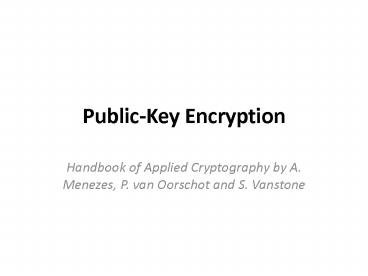PublicKey Encryption - PowerPoint PPT Presentation
1 / 20
Title: PublicKey Encryption
1
Public-Key Encryption
- Handbook of Applied Cryptography by A. Menezes,
P. van Oorschot and S. Vanstone
2
Introduction
- asymmetric encryption
- each entity A has a public key e and a
corresponding private key d - the task of computing d given e is
computationally infeasible - The public key defines an encryption
transformation Ee - the private key defines the associated decryption
transformation Dd. - c Ee(m), m Dd(c)
3
(No Transcript)
4
Publicity
- The public key need not be kept secret, and, in
fact, may be widely available. - The main objective of public-key encryption is to
provide privacy or confidentiality. - The data origin authentication or data integrity
must be provided through use of additional
techniques, including message authentication
codes and digital signatures.
5
(No Transcript)
6
Properties of Public-key encryption
- slower than symmetric-key encryption algorithms
such as DES - Most commonly used in practice for the transport
of keys subsequently - encrypting small data items such as credit card
numbers and PINs
7
The number-theoretic computational problems
8
Basic principles
- Objectives of adversary
- recover plaintext from ciphertext
- key recovery
- Types of attacks
- chosen-plaintext attack
- chosen-ciphertext attack
- Distributing public keys
- trusted channel, trusted public file, using an
on-line trusted server, or an off-line server and
certificates - Message blocking
- Plaintext messages longer than some fixed size
(bitlength) must be broken into blocks.
9
RSA public-key encryption
- 1977, R. Rivest, A. Shamir, and L. Adleman
- provide both secrecy and digital signatures
- security is based on the intractability of the
integer factorization problem
10
(No Transcript)
11
(No Transcript)
12
(No Transcript)
13
(No Transcript)
14
Security of RSA
- Relation to factoring
- Small encryption exponent e
- Forward search attack
- Small decryption exponent d
- Multiplicative properties
- Common modulus attack
- Cycling attacks
- Message concealing
15
RSA problem (RSAP)
- recovering plaintext m from the corresponding
ciphertext c given the public information (n, e) - There is no efficient algorithm known for this
problem. - first factor n, and then compute ? and d
- If d known, then n will be factorized.
16
Cycling attacks
17
RSA encryption in practice
- fast modular multiplication, fast modular
exponentiation - the Chinese remainder theorem for faster
decryption - Even with these improvements, RSA
encryption/decryption is substantially slower
than the commonly used symmetric-key encryption
algorithms such as DES. - In practice, RSA encryption is most commonly used
for the transport of symmetric-key encryption
algorithm keys and for the encryption of small
data items
18
Notes on RSA
- recommended size of modulus
- 1024-bit or larger
- selecting primes
- p and q should be about the same bitlength, and
sufficiently large - p - q should not be too small
- small encryption exponents
19
Other public-key encryptions
20
(No Transcript)

